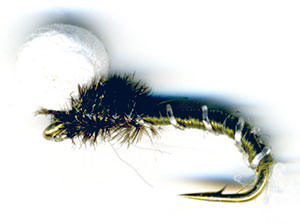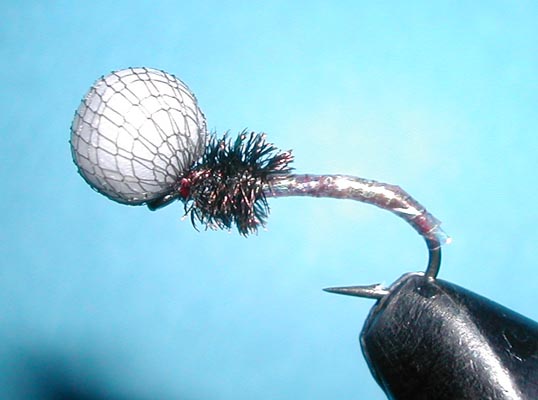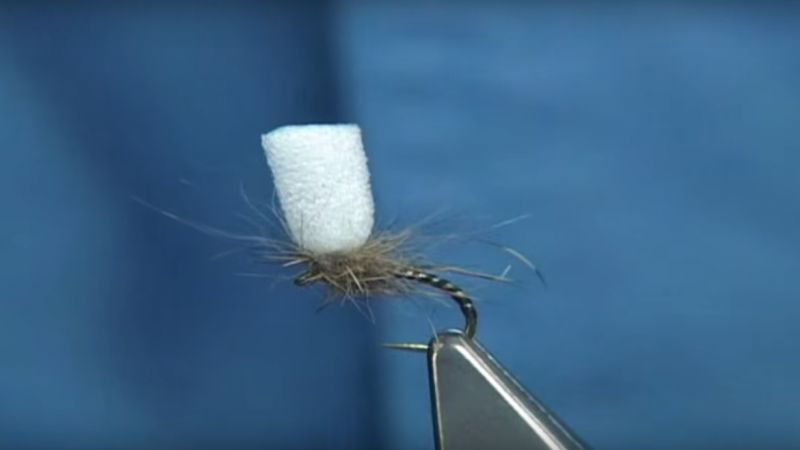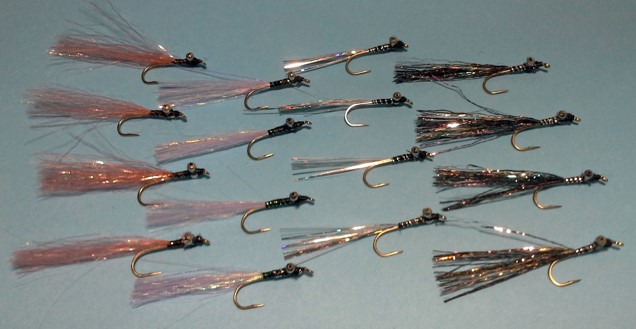

The Sugar Cube Emerger, or suspender buzzer, is a fairly easy fly to tie using only a few materials but it’s very effective, especially on still water trout.
Materials
- Hook: Light weight curved hook like a Kamazan B100 or Tiemco 2487 in sizes 10-20
- Thread: Uni 8/0 or UTC 70 denier
- Tag: Flat gold, silver or pearl tinsel
- Rib: as tag
- Abdomen: Dubbing of your choice
- Thorax: As abdomen
- Head: Plastazote, or other high-density foam cut into a strip. The size will depend on the size of your fly. Alternatively, foam bead wrapped in nylon stocking (left).
Tying Instructions
- Start thread half way down the hook shank and in close wraps wind towards the hook eye.
- Stop 1 mm short of eye and tie in plastazote and cut to length.
- Take tying thread in close wraps to half way round the hook bend.
- Catch in ribbing.
- Dub seals fur substitute sparsely onto the tying thread and in close turns wind dubbing up to plastazote.
- Now take ribbing and in open turns, wind until you reach the foam.
- Dub on more seal fur substitute and form the thorax. Then tie off.
https://youtu.be/IrCJtqCQ_es
See also pp.106-107 of The Fly-tying Bible.
Davie McPhail’s Sugarlump Emerger
- Hook: B160 size 14.
- Thread: White UTC 70.
- Rib: Black sharpie pen to colour white thread to create rib.
- Wing: White eva foam
- Hackle: Natural squirrel dubbing.
An alternative to the popular CDC emerger, the Sugarlump avoids some of its flaws. Emerger fly patterns aim to imitate pupae as they hatch and emerge from the water’s surface and rely on a buoyant wing bud to hold the fly in place in the meniscus.
Wings fashioned from CDC feathers are a common choice as the CDC traps air in its fibres making the feathers very efficient at keeping the fly suspended. However, with time they can get slimed up by the trout and waterlogged and so their buoyancy is compromised.
Instead, Davie McPhail’s Sugarlump uses a foam post attached in the wing bud position. Aside from the fact that it won’t get waterlogged like feathers, and is a more durable material, the white foam cube is highly visible to the angler, and acts as a useful sight aid as this fly is designed to sit low in the water surface and so would be difficult to see.
This makes it a good fly for the beginner to fly fishing to use, and also means you don’t have to resort to using an indicator. Under the water, the contrasting black and white ribbing create a midge-like impression with the squirrel dubbing implying emerging legs.
These are excellent flies to use when dry flies on the surface are being ignored and the fish are taking the insects hanging in the water’s surface film. Refraction means the foam post will not be visible to the trout and so spook them, but Davie recommends that on calm days, with particularly flat water, you might want to reduce the length of the foam.
Davie also recommends playing with the positioning of the cube as this will influence how the fly sits in the water. A good tip is to tie up a practice one and see how it floats in a glass of water to get the positioning spot on.
This is quite a straightforward fly to tie and Davie gives some good advice on tapering the foam before attaching it. The foam is attached in a parachute style, a good technique to master as it is often used for emerger patterns.
https://youtu.be/1OICglx-P_A




